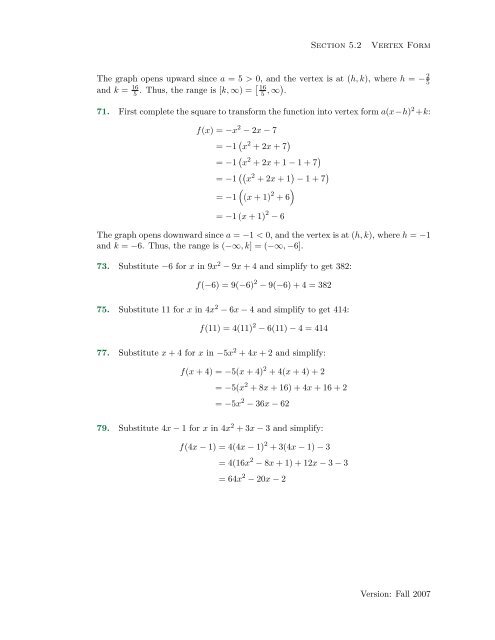Chapter 5: Exercises with Solutions
Chapter 5: Exercises with Solutions
Chapter 5: Exercises with Solutions
- No tags were found...
You also want an ePaper? Increase the reach of your titles
YUMPU automatically turns print PDFs into web optimized ePapers that Google loves.
Section 5.2Vertex FormThe graph opens upward since a = 5 > 0, and the vertex is at (h, k), where h = − 2 5and k = 16 5 . Thus, the range is [k, ∞) = [ 165 , ∞) .71. First complete the square to transform the function into vertex form a(x−h) 2 +k:f(x) = −x 2 − 2x − 7= −1 ( x 2 + 2x + 7 )= −1 ( x 2 + 2x + 1 − 1 + 7 )= −1 (( x 2 + 2x + 1 ) − 1 + 7 )()= −1 (x + 1) 2 + 6= −1 (x + 1) 2 − 6The graph opens downward since a = −1 < 0, and the vertex is at (h, k), where h = −1and k = −6. Thus, the range is (−∞, k] = (−∞, −6].73. Substitute −6 for x in 9x 2 − 9x + 4 and simplify to get 382:f(−6) = 9(−6) 2 − 9(−6) + 4 = 38275. Substitute 11 for x in 4x 2 − 6x − 4 and simplify to get 414:f(11) = 4(11) 2 − 6(11) − 4 = 41477. Substitute x + 4 for x in −5x 2 + 4x + 2 and simplify:f(x + 4) = −5(x + 4) 2 + 4(x + 4) + 2= −5(x 2 + 8x + 16) + 4x + 16 + 2= −5x 2 − 36x − 6279. Substitute 4x − 1 for x in 4x 2 + 3x − 3 and simplify:f(4x − 1) = 4(4x − 1) 2 + 3(4x − 1) − 3= 4(16x 2 − 8x + 1) + 12x − 3 − 3= 64x 2 − 20x − 2Version: Fall 2007
















